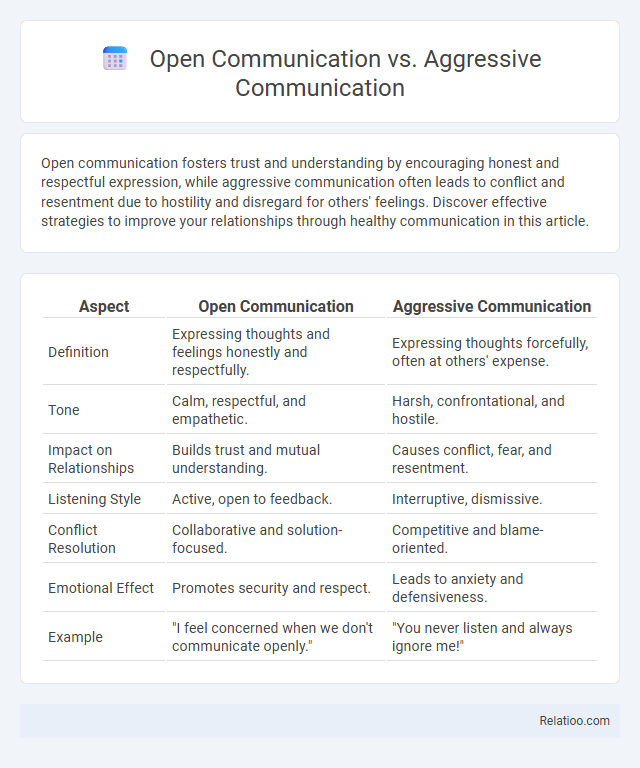Open communication fosters trust and understanding by encouraging honest and respectful expression, while aggressive communication often leads to conflict and resentment due to hostility and disregard for others' feelings. Discover effective strategies to improve your relationships through healthy communication in this article.
Table of Comparison
| Aspect | Open Communication | Aggressive Communication |
|---|---|---|
| Definition | Expressing thoughts and feelings honestly and respectfully. | Expressing thoughts forcefully, often at others' expense. |
| Tone | Calm, respectful, and empathetic. | Harsh, confrontational, and hostile. |
| Impact on Relationships | Builds trust and mutual understanding. | Causes conflict, fear, and resentment. |
| Listening Style | Active, open to feedback. | Interruptive, dismissive. |
| Conflict Resolution | Collaborative and solution-focused. | Competitive and blame-oriented. |
| Emotional Effect | Promotes security and respect. | Leads to anxiety and defensiveness. |
| Example | "I feel concerned when we don't communicate openly." | "You never listen and always ignore me!" |
Understanding Open Communication
Understanding open communication involves fostering a transparent environment where individuals express thoughts and feelings honestly while respecting others' perspectives. This approach contrasts with aggressive communication, which often includes hostile or confrontational language that can damage relationships and hinder collaboration. Emphasizing active listening and empathy, open communication promotes trust, reduces misunderstandings, and encourages constructive dialogue in personal and professional settings.
Defining Aggressive Communication
Aggressive communication involves expressing your needs or opinions forcefully, often at the expense of others' feelings or rights, characterized by hostility, domination, and disregard for constructive dialogue. It contrasts with open communication, which encourages honest, respectful exchanges where all parties feel heard and valued. Recognizing aggressive communication helps you maintain healthier interactions by promoting assertiveness without infringing on others' boundaries.
Key Differences Between Open and Aggressive Communication
Open communication involves expressing thoughts and feelings honestly and respectfully, fostering trust and collaboration in relationships. Aggressive communication, by contrast, uses forceful language and dominates conversations, often leading to conflict and resentment. Key differences include tone, intent, and impact: open communication encourages understanding and problem-solving, while aggressive communication prioritizes winning arguments and silences opposing views.
Benefits of Open Communication in Relationships
Open communication fosters trust and emotional intimacy by encouraging honesty and understanding between partners, which reduces conflicts and misunderstandings. Unlike aggressive communication, which often leads to defensiveness and resentment, open communication prioritizes respect and active listening, facilitating healthier conflict resolution. Maintaining open communication strengthens relationship satisfaction and long-term commitment by promoting transparency and mutual support.
Negative Impacts of Aggressive Communication
Aggressive communication often leads to misunderstandings, increased conflict, and damaged relationships due to its confrontational and hostile nature. Unlike open communication, which fosters trust and collaboration, aggressive communication can create a toxic environment, reduce team morale, and decrease overall productivity. These negative impacts highlight the importance of adopting open communication strategies to ensure effective and respectful dialogue.
Signs of Effective Open Communication
Effective open communication is characterized by active listening, clear and respectful expression of ideas, and the ability to provide constructive feedback without judgment or hostility. These signs foster trust and collaboration, contrasting sharply with aggressive communication, which often involves domination, interrupting, or blaming, leading to conflict and misunderstandings. You can enhance your interpersonal relationships by practicing openness, empathy, and non-verbal cues like maintaining eye contact and using an even tone.
Recognizing Aggressive Communication Patterns
Recognizing aggressive communication patterns involves identifying behaviors such as interrupting, blaming, or using a confrontational tone that can hinder effective dialogue and damage relationships. Your ability to distinguish open communication--which emphasizes honesty and respect--from aggressive communication enables more productive and empathetic interactions. Open communication fosters trust and collaboration by encouraging active listening and expressing thoughts without intimidation or hostility.
Strategies to Shift from Aggressive to Open Communication
Shifting from aggressive to open communication requires practicing active listening, where individuals attentively understand the speaker's message without interrupting or judging. Implementing empathy enhances emotional intelligence, allowing one to recognize and respect others' feelings and perspectives, which reduces hostility. Setting clear, respectful boundaries and using assertive language instead of confrontational statements fosters a cooperative environment conducive to transparent and effective dialogue.
Real-Life Examples: Open vs. Aggressive Communication
Open communication fosters trust and collaboration in workplaces, exemplified when team members share feedback constructively during project meetings, leading to enhanced problem-solving and morale. Aggressive communication often results in conflict and resentment, such as a manager shouting at employees for missed deadlines, which creates a hostile environment and reduces productivity. Real-life scenarios highlight that open communication encourages transparency and mutual respect, while aggressive communication undermines team dynamics and stifles innovation.
Building a Culture of Open Communication
Building a culture of open communication fosters trust, collaboration, and transparency within organizations by encouraging honest dialogue and active listening. Unlike aggressive communication, which can create conflict and reduce morale due to its confrontational nature, open communication promotes mutual respect and understanding among team members. Implementing strategies such as feedback loops and inclusive meetings strengthens psychological safety and drives collective problem-solving.

Infographic: Open Communication vs Aggressive Communication
 relatioo.com
relatioo.com